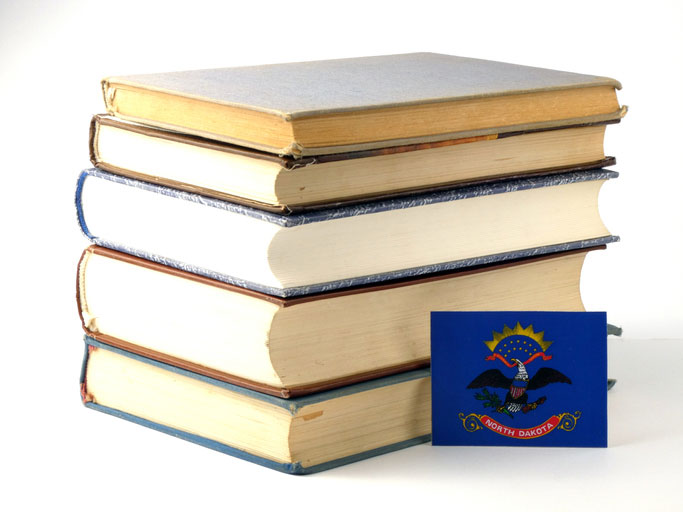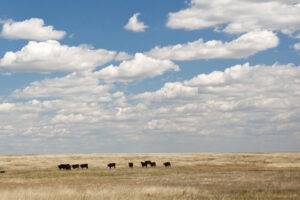Written by Alex Dorian

North Dakota is forever ingrained as an integral part of the nation’s literary landscape. Whether it’s the impact of the great novels that have been set here in the Great Plains or the fact that the state has produced nationally-renown writers generation after generation, any honest exploration of America’s writing legacy will take you through North Dakota.
North Dakota’s landscape has graced the work by great American authors from John Steinbeck to Sinclair Lewis to Louise Erdrich. It’s been home to the likes of Louis L’Amour and successful modern authors including Rich Karlgaard and Chuck Klosterman.
There’s a long line of noteworthy writers with connections to North Dakota, both stretching back a century and reaching forward into the modern era of contemporary literature.
An Ideal Place for Solitude and Reflection
 There’s something unique about North Dakota and how it affects writers.
There’s something unique about North Dakota and how it affects writers.
It affected John Steinbeck when he came through with his dog Charlie in 1960 as part of a cross-country road trip that inspired his travelogue, Travels with Charlie: In Search of America.
Before he came Steinbeck had the preconception that Fargo saw the most extreme weather of any city on the continent. When he’d check the national forecast in a newspaper, if it was hot then Fargo would have the hottest temperature, and if it was cold then Fargo would have the coldest temperature.
However, when he actually arrived in North Dakota, what he described in greatest detail were the Badlands: “They deserve this name. They are like the work of an evil child,” he initially said. But as the day grew on and the sunlight changed, so did Steinbeck’s impression of them:
“[They] glowed with yellow and rich browns and a hundred variations of red and silver gray, all picked out by streaks of coal black…once stopped I was caught, trapped in color and dazzled by the clarity of the light.”
~ John Steinbeck
Sinclair Lewis won a Pulitzer Prize for his 1925 novel Arrowsmith, which includes North Dakota as a setting to represent the quintessential rural American countryside hamlet. The novel is known for its accuracy in portraying conflicts that arise within medical research: commerce versus altruism versus experiment design; themes that are as relevant today as they ever have been.
More recently, the well-known prolific writer Martha Grimes has visited the state in her fiction, especially in her 2008 book Dakota published by Viking/Penguin. Grimes used the setting of the state as a logical choice to feature an enormous industrial pig farm and the theme of modern livestock management.
North Dakota’s rural reputation and natural beauty has clearly made its way into the national consciousness as a setting for many noteworthy works.
Besides serving as a great setting, North Dakota is also home to significant movers and shakers in the literary world.
Writing no less than 101 books, Jamestown-native Louis L’Amour is perhaps the most prolific and best-known author in the frontier Western genre, a master of archetypal figures like cowboys, gunslingers, and sheriffs; an ultimate good-versus-evil themehound. Winner of many awards including the National Gold Medal for lifetime literary achievement, today around 200 million copies of his books are in print.
The publisher of Forbes Magazine between 1998 and 2018 and its current editor-at-large, Rich Karlgaard was born and raised in Bismarck. He’s also an award-winning author.
Cultural critic, essayist, novelist, and non-fiction writer Chuck Klosterman grew up on a farm in Richland County. Born in 1973, he’s written for countless household-name publications including The New York Times, The Washington Post, The Guardian, GQ, Esquire, and more.
You could be the next great writer telling the story of your start in North Dakota if you’ve got the grind and the grit it, along with the right education through an undergraduate or graduate degree in creative writing.
North Dakota’s Creative Writing Classes, Courses, and Workshops Can Prepare You for a Creative Writing Degree
So what is the secret formula for having what it takes? Unfortunately, there’s no simple answer. Here’s how Louis L’Amour said he did it:
“I start with a character and a situation, but I don’t know what’s going to happen until I write it. Sometimes things happen that surprise me.”
~ Louis L'Amour
It’s different for everyone. But as L’Amour alludes, you have to start somewhere.
You can find support as an aspiring writer at venues throughout the state. The BisMan Writers Guild is one such resource, existing to uplift local writers from across the North Dakota. It sponsors events like open mic nights and meet-and-greets for fellow authors at coffee shops, libraries, and bars in rotating cities. If you’re virtual then you can participate in regular write-ins. They also host writing workshops.
Poetry Out Loud takes place every year. It’s a country-wide competition that starts at the state level with a recitation contest. Finalists go on to compete nationally. It’s sponsored in part by Humanities North Dakota, a non-profit organization that puts on affordable humanities-related events like local author readings, meet-and-greets, and reading groups.
Every year the University of North Dakota hosts a writers conference that’s free and open to the public. This is a great opportunity to network with those in the industry, gain insights from experienced authors, meet fellow creative writers, and hob-nob with publishers looking for new talent.
Keep up with the latest in the local and regional literary world with the North Dakota Quarterly. It’s a public humanities and literary journal published out of Grand Forks.
Writing Colleges in North Dakota Offering Bachelor’s and Master’s Degrees in Creative Writing Provide a Path to Becoming a Writer
You can do a lot to improve your craft. Creative writing isn’t a solitary sport. You have an audience, for one, and if you’re planning on getting published then you’ll work with editors and agents too.
You can cross-pollinate ideas with other writers in workshops till the cows come home, but odds are that eventually you’re going to hit a ceiling.
This is the point where degree in creative writing comes into focus, whether a BA or BFA (Bachelor of Fine Arts) at the undergraduate level, or an MA or MFA (Master of Fine Arts) at the graduate level. Professors who have been-there-and-done-that can provide valuable insights that only come with decades of experience. And you’ll find fellow writers who all share the same goal of being impactful writers, if not also published professionals.
Bachelor of Fine Arts (BFA) and Other Bachelor’s Degrees in Creative Writing in North Dakota
- There are no listings for North Dakota Bachelor of Fine Arts at this time.
Master of Fine Arts (MFA) and Other Master’s Degrees in Creative Writing in North Dakota
- There are no listings for North Dakota Bachelor of Fine Arts at this time.




